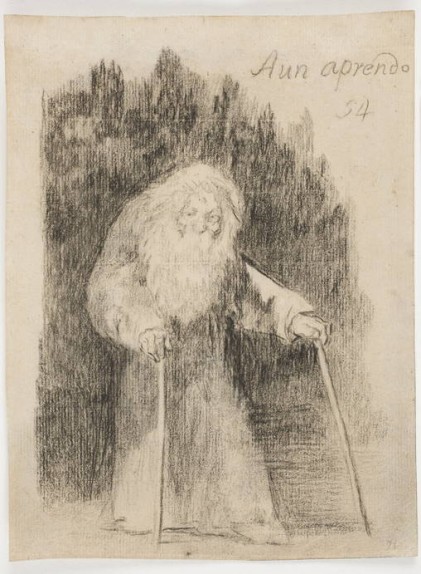My first memory of Francisco Goya paintings stems from a recently resurfaced memory of my father copying one of his autoportrait; that picture was constantly staring at me and as a child I didn’t like it at all. Only later I started to love Goya paintings, mostly the black paintings and the “caprichos”, but the one that I most cherish is a very small piece of work “Aun aprendo”, that received very little attention. Compared to Goya production is almost nothing: An old man, with a white beard, leaning on his sticks to move forward. Except that Goya made this small drawing when he was very old, between 1828 and 1828. In 1828, the year he died, he was 82 years old. By that time Francisco Goya was almost blind but still experimenting with lithography, a technique just developed, so he was not merely repeating himself.
Goya was really still keen to learn as witnessed by the old man lively eyes. It is a moving image to think about a man, toward the end of his days, still willing and capable to learn and experience new possibilities. What are the limits of human learning? Is it still possible to learn regardless of our age? This is a fascinating question, that received for many years a negative answer, based mostly on the idea that it is not possible to alter a hugely complex system, like our brain, without disrupting it.
This view was also supported by two related findings: imprinting and critical periods. Imprinting was first noticed in birds and fully explained by the Nobel prize winner Konrad Lorenz, who devised several clever experiments. Lorenz split a large clutch of greylag goose eggs into 2 groups. The control group was allowed to hatch normally and the goslings followed their mother around. The second group of eggs incubated and Lorentz was the first thing the goslings saw when they hatched. These goslings followed him everywhere (imprinting).
When he marked the goslings as to which group of eggs they had hatched from and then let them out together from an upturned box, each gosling went straight to its “mother figure”. Today the possibility of imprinting in a bird a human parent figure is used to reintroduce birds into the wild, as dramatized in the movie “Fly away”. An important aspect of imprinting is the existence of an extremely narrow time window, the critical period where imprinting is possible. Many phenomena occur only in very narrow time windows, in birds the formation of sexual preferences is also related to a critical period, as well known in falconry. In mammals usually the word attachment is used but a very similar pattern emerges with the formation of bonding and sexual preferences having to occur at specific time. The notion of a critical period was proposed in relationship with absolute pitch recognition, language learning and binocular 3D stereo view. 3D stereo view has been studied for centuries, Charles Wheatstone was the first to suggest that "… the mind perceives an object of three dimensions by means of the two dissimilar pictures projected by it on the two retinae...", however this can only happen if the eyes are correctly aligned. In babies the eyes are almost completely independent, they can sleep with one eye open or look in two different directions, until, between 3 and 8 months, the eyes become correctly aligned and at that point it will become extremely challenging for him to misalign them.
The degree of alignment is not the same in all humans, Oliver Sacks for instance had a spectacular 3D vision, and it is possible that 3D vision can be the discriminating factor between a good and an amazing basketball or football player.
However if something went wrong, for instance the length or the attachment points of the muscles controlling each eye are too different the brain can’t merge the images; amblyopia can develop with the formation of double images in the brain and in some cases the removal of the disturbing ghost image.
Obviously with only one eye at work 3D vision is impossible. For this reason, once such vision troubles are spotted, the advice is too intervene as early as possible. A late intervention would leave vision impaired forever, except that, as living beings we should know that nothing is forever. In "Fixing my gaze" Susan R. Barry narrates her moving experience of discovering 3D stereo vision at 46 using vision therapy, what was considered completely impossible till recently. Her description of the feelings she experienced during the recovery is beautiful and vividly report the sensations experienced during an intense reshaping of the visual and motor cortex. At the very beginning the new function is unstable and, especially in stressful situation it vanishes again, moving toward consolidated habits, progressively the function becomes stable and unconscious. Most important: It is not enough to use the eyes to see, we need to integrate vision with the other senses, in particular touch, to understand the world. Susan R. Barry describes her perceptual shift whilst she was trying to locate the projection of a rope circle on a wall, in her words[1]:
“I’m not sure,” I said hesitantly. “I think its on the wall” Dr. Lessmann handed me a long pole and instructed me to place the tip of the pole in the center of the rope circle so that it touched the wall. I put the tip of pole in the center of the rope circle but I couldn’t feel the wall. It was disorienting,[…] much like the sensation you have when you descend a staircase and underestimate the height of a step. […] Eventually I hit the wall. “Give the wall a hard tap,” Dr. Lessmann commanded. I did, and, in a single moment, everything changed. The rope circle shrank in diameter and appeared to float in front of the wall.
This is one of the best description of Functional integration, a change of the perception of reality is achieved through the convergence of the senses. A similar convergence of senses is described by M. Feldenkrais in the "Case of Nora"[2]. He realised that her eyes were no longer coordinated after a stroke and he conceived a device to allow her to achieve the eye convergence, similar to the one described by Susan R. Barry. The fact that such perceptual shifts can happen at 46 opens new perspective to possible recovery.
[1] Susan R. Barry, Fixing my gaze
[2] M. Feldenkrais, Body Awareness as Healing Therapy: The Case of Nora


